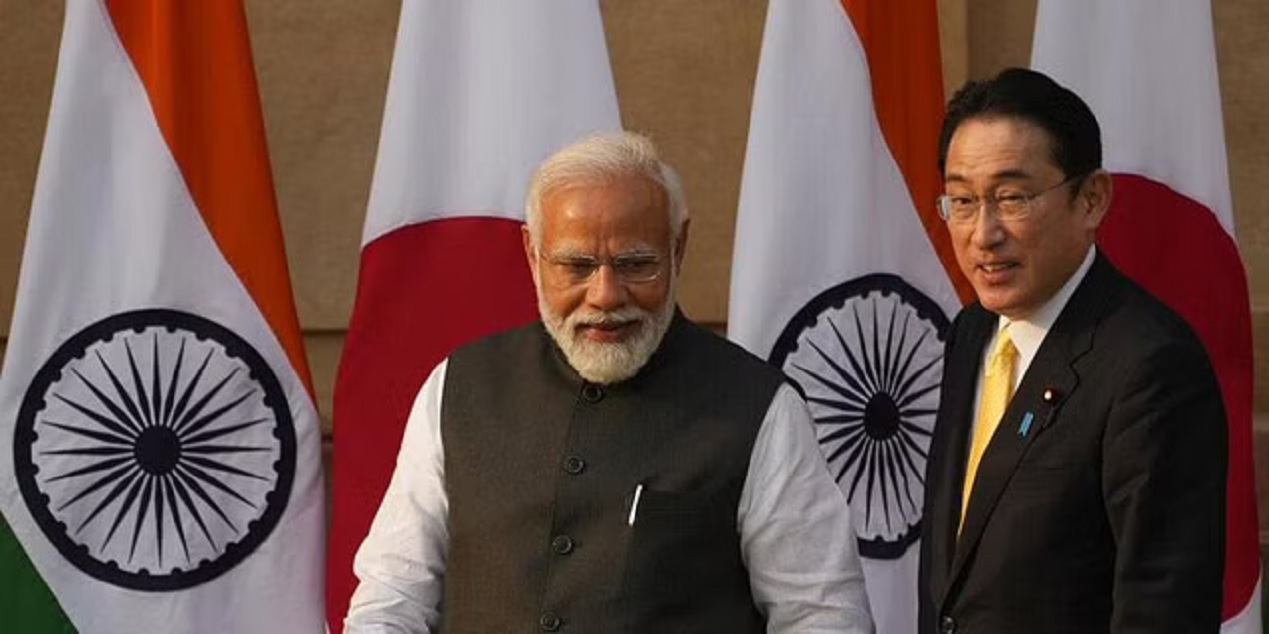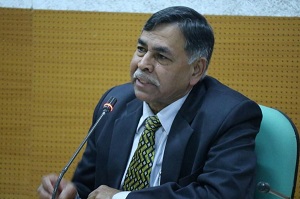The Japanese Prime Minister Fumio Kishida paid a two-day official visit to India on 19-20 March 2022 for the annual India-Japan Annual Summit with his Indian counterpart Narendra Damodardas Modi. This was Kishida’s first visit to India as Prime Minister and the first meeting with Prime Minister Modi. The last India-Japan summit took place in 2018 in Tokyo. This was the 14th such summit between the prime ministers of the two countries.
Kishida is not unknown in India. As Japan’s Foreign Minister earlier, he visited India and met Modi four times before in that capacity. He also met the PM as Liberal Democratic Party’s Policy Research Council’s Chairman. On one occasion, Kishida had addressed a gathering at the Indian Council of World Affairs, a think tank supported by the Ministry of External Affairs. The year 2022 marks the 70th anniversary of the establishment of diplomatic relations between the two countries[1] and Kishida’s decision to visit India at this point of time and see in person the “tremendous dynamism” demonstrated by India makes the visit extraordinarily significant, signifying how each side look at each other.
Major Takeaways
What are the major takeaways of the meeting? A lengthy joint statement was issued, wherein a Memorandum of Cooperation was signed on Cyber security, seven JICA loans for various projects in India, and some amendments to the Comprehensive Economic Partnership Agreement (CEPA) were carried out. Besides, a Memorandum of Cooperation on Decentralised Domestic Wastewater Management, an India-Japan Industrial Competitiveness Partnership Roadmap, and an agreement on Sustainable Urban Development were signed. A Clean Energy Partnership as well as a Sustainable Development for the North Eastern Region of India was also launched. It may be noted that both sides have successfully implemented the 2014-2019 investment target of 3.5 trillion Japanese yen as part of the Investment Promotion Partnership. A target for the next five years has been set for 5 trillion Japanese yen.
Besides bilateral issues, the two PMs discussed the Ukraine issue as well as China. The visit coming in the wake of developments in Ukraine and China’s assertiveness on a host of issues, underlined the importance of strengthening ties between the two countries. Since the time when Abe Shinzo was Prime Minister, Japan has consistently expressed concern about China’s military build-up. The government of Kishida has also announced an increase of 7.1 per cent in military spending in 2022. On the Ukraine issue, India and Japan have adopted divergent policy stances and Kishida’s visit was to seek an understanding between the two countries on the Ukraine crisis that has threatened world peace. Japan fears that China might take advantage of the situation in Ukraine and interpret Russia’s military operation in Ukraine as permission for its own invasion of Taiwan. Even Senkaku island dispute with Japan could be also on the edge. Such a scenario puts the security scenario in the Indo-Pacific region in delicate balance. No wonder, Kishida and Modi discussed this sensitive issue and how to seek solution so that no stakeholder’s interest is adversely affected.
At a time when the Quad initiative was developing as an important forum to address the security issues in the Indo-Pacific region, India’s stance that was in variance with the rest three Quad members posed a new challenge for the Quad to maintain its effectiveness. Fortunately, Australia clarified that Quad member countries accepted India’s position on the crisis in Ukraine as Prime Minister Modi went on an overdrive to reach out to his counterparts in Russia in Ukraine, besides other world leaders calling for an end to the conflict in that country. Australian clarification came from High Commissioner Barry O’Farrell a day before a virtual summit between Modi and his Australian counterpart Scott Morrison.
Indeed, India's position on the Russian attack on Ukraine appeared to be driven by former Prime Minister Jawaharlal Nehru's policy in 1957 that India was not in the business of condemnation and it focuses on creating a space for resolution of conflicts. That policy of neutrality on developments outside of India has remained consistent since then and it is driven purely in the national interest. Kishida, therefore, had treason to be convinced when Modi said the Russian invasion of Ukraine has “shaken” the roots of international order and asserted that attempts to alter the status quo by using force in any region should never be tolerated. As said, except for India, the three other Quad member countries have been severely critical of Russia for its military aggression against Ukraine. The US too told that if India accepts the Russian offer of discounted crude oil, it would not be a violation of the US sanctions on Moscow, while observing that countries should also think about “where you want to stand” on the Russian action.[2] The joint statement therefore appropriately mentioned both leaders expressed serious concern over the conflict and pitched for an immediate end to violence and resolution of the situation through dialogue and diplomacy. During the talks while Kishida was categorical in remarking that the Russian aggression against Ukraine has “shaken the foundation of international order”, Modi did not mention Ukraine directly and referred to “geopolitical developments”.[3]
Commitment to Upscale Investment
The noteworthy outcome of the Kishida visit was the big-ticket investment announcement of 5 trillion Japanese yen ($42 billion) in India to finance relevant public and private investment projects of mutual interest, exceeding the previous investment target of 3.5 trillion Japanese yen (approx. $29.4 billion) announced in 2014. The new target for the next five years will provide scope for greater involvement of Japanese companies in the Indian economy. Indeed, since the elevation of bilateral ties to a Special Strategic and Global Partnership, there had been significant growth in economic cooperation. [4]
In February 2022, India and Japan represented by the Department for Promotion of Industry & Internal Trade (DPIIT) and Ministry of Economy, Trade and Industry (METI) respectively, conducted an annual review of progress made under Japanese Industrial Township (JITs) in India. They were set up pursuant to the ‘Action Agenda for the India-Japan Investment and Trade Promotion and Asia-Pacific Economic Integration’ signed between the Governmental ministries of the two countries in 2015. At present, there are 114 Japanese companies operating across the JITs. The Neemrana (Rajasthan) and Sri City (Andhra Pradesh) house marquee Japanese investors such as Daiken, Isuzu, Kobelco, Yamaha Music, Hitachi Automotive etc.
Japan is India’s fifth largest investor, having contributed over $36.2 billion in cumulative investments since 2000. These investments have been directed to sectors such as automobiles, electronics system & manufacturing, medical devices, consumer goods, textiles, food processing and chemicals. Both also have a Comprehensive Economic Partnership Agreement (CEPA) in place.
Both Modi and Kishida welcomed the formulation of a roadmap under the India-Japan Industrial Competitiveness Partnership (IJICP) to further promote industrial cooperation between the two countries in the areas of MSMEs, manufacturing and supply chains. Collaboration in addressing illicit technology transfers, build resilient supply chains and strengthen the protection of critical infrastructure, including through the Quad, were the highlights of the joint statement.
Other highlights were signing pacts on cyber security and clean energy partnership. Both also stressed that the 2+2 meeting between the foreign ministers of both the countries should commence soon. Pacts on loans to the tune of Rs. 20,400 crore for projects in connectivity, water supply and sewerage, horticulture, healthcare, and biodiversity conservation in different starts were other highlights.
Following Modi-Kishida summit and joint statement, Japanese automobile major Suzuki Motor Corporation (SMC) said it would invest about 150 billion yen (approx Rs. 10,440 crore) by 2026 for local manufacturing of electric vehicles (BEV) and BEV batteries, in Gujarat. [5] The objective is to achieve carbon neutrality with small cars for which India provides a large market. That prospect attracts the Japanese automobile giant. In fact, the MoU was signed on 19 March 2022 at the India-Japan Economic Forum held in New Delhi in the presence of both the Prime Ministers. Suzuki’s decision is in conformity with India’s aim to become Atmanirbhar or realise self-reliance. Additionally, as part of the MoU, Suzuki Motor Gujarat (SMG), a subsidiary of the SMC, will invest Rs. 3,100 crore by 2025 for increasing production capacity for BEV manufacturing and Rs. 7,300 crore by 2026 for construction of plant for BEV batteries. Also, Maruti Suzuki Toyotsu India, a joint venture between Maruti Suzuki India and Japan-based Toyota Tsusho Group, will invest Rs. 45 crore for construction of vehicle recycling plant by 2025.
Writing in an exclusive piece in the Indian Express on 19 March 2022, Kishida explained his aim to realise a “new form of capitalism” with the aim to revive the economy through a virtuous cycle of growth and distribution. Kishida looks at India as the best partner to realise his objective. He was impressed that India “showcased its contribution in response to the global health crisis as a manufacturing base, leadership in decarbonisation efforts, including through the International Solar Alliance, engagement in advanced digital society initiatives such as Aadhaar, and promotion of economic security initiatives, including measures for supply chain resilience”.[6]
More than the strategic convergence of interests which have seen some fault-lines at times, (Ukraine issue for example), it is the economic component that provides a stronger spine to the bilateral relationship. There are close to 1,500 Japanese companies operating in India now. The figure could be much more as some companies are not registered. Among major highlights, eleven Japan Industrial Townships have been established, with Neemrana in Rajasthan and Sri City in Andhra Pradesh having maximum number of companies.[7]
Japanese Official Development Assistance (ODA) has played a significant role in the economic development of India. Several infrastructure projects such as the Mumbai-Ahmedabad High Speed Rail (shinkansen project), Dedicated Freight Corridor, metro projects, DMIC etc have been possible because of the Japanese ODA. Besides collaborations in start-ups, both have also cooperated in the field of ICT, in areas such as 5G, under-sea cables, telecom and network security. Cooperation on skill development is another area where both sides have found synergy. Nineteen India-Japan Institutes of Manufacturing (JIM) have been established by Japanese companies based on India for training skilled worker. Health care sector is another area where cooperation prospects look promising.
These are some of the ongoing projects that are going to get a fillip following Kishida’s visit. As both countries move on, both countries shall look for new areas where cooperation and collaboration shall be mutually beneficial. In the political realm, barring exceptions such as in the Ukraine issue, both nations share common viewpoints. China’s aggressive intent in regional issues shall propel both India and Japan to find more synergy to jointly cope up with this new challenge.
Endnotes :
[1] Diplomatic relations between the two countries were established on 28 April 1952 and this year marks the 70th year of this relationship and thus a milestone year.
[2] https://news.rediff.com/commentary/2022/mar/20/quad-nations-accept-indias-stand-on-ukraine-australia/718672f54d4b750b7b149c913e5fbb1d
[3] “India-Japan Summit Joint Statement Partnership for a Peaceful, Stable and Prosperous Post-COVID World”, 19 March 2022, https://www.mea.gov.in/bilateral-documents.htm?dtl/34991
[4] Shubhajit Roy, “$42-bn investment from Japan, Kishida & Modi say ties deepening”, Indian Express, 20 March 2022, https://indianexpress.com/article/india/japanese-pm-fumio-kishida-meets-narendra-modi-7827043/
[5] “Suzuki to invest ₹10,445 crore for local manufacturing of electric vehicles, batteries in Gujarat”, The Hindu, 20 March 2022, https://www.thehindu.com/business/Industry/suzuki-to-invest-10445-crore-for-local-manufacturing-of-electric-vehicles-batteries-in-gujarat/article65242901.ece?homepage=true
[6] Fumio Kishida, “India and Japan: A Special Partnership”, The Indian Express, 19 March 2022, https://indianexpress.com/article/opinion/columns/fumio-kishida-visit-indo-japanese-ties-covid-russia-ukraine-conflict-19-7826160/
[7] Shubhajit Roy, “Explained: 5 reasons why Japanese PM Fumio Kishida’s India visit is important”, Indian Express, 19 March 2022, https://indianexpress.com/article/explained/explained-japan-pm-fumio-kishidas-india-visit-narendra-modi-7826828/
(The paper is the author’s individual scholastic articulation. The author certifies that the article/paper is original in content, unpublished and it has not been submitted for publication/web upload elsewhere, and that the facts and figures quoted are duly referenced, as needed, and are believed to be correct). (The paper does not necessarily represent the organisational stance... More >>
Image Source: https://images.newindianexpress.com/uploads/user/imagelibrary/2022/3/20/w900X450/Kishida_AP.jpg?w=640&dpr=1.0










Post new comment